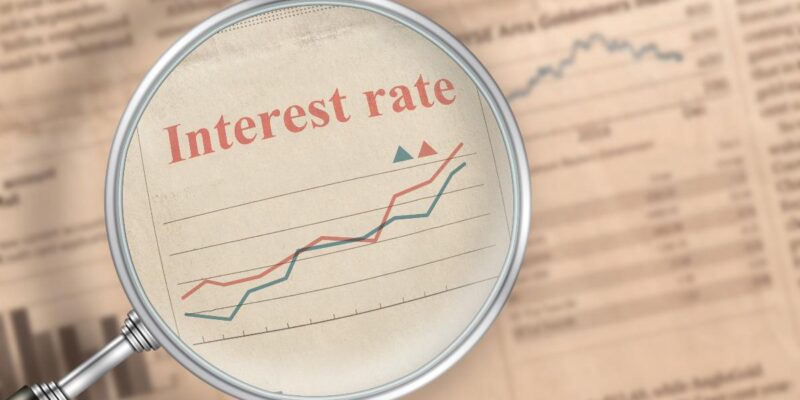
In the international fixed-income markets, interest rates are rising, and the decades-long trend of declining bond yields has undoubtedly been broken. On August 2, 2022, the ten-year United States Treasury yield was 0.5 percent; on October 9, 2023, it had risen to 4.8 percent. Long-term interest rates in Europe, Asia, and Latin America have also risen sharply. The key reason for the rise in capital market interest rates is the central banks’ interest rate hikes—a direct response to sky-high inflation (caused by the central banks themselves, following a huge increase in the quantity of money).
Figure 1: Ten-year US Treasury bond yield with constant maturity from January 1981 to October 11, 2023 (percent)
Source: FRED. Data from the Board of Governors of the Federal Reserve System.
Initially, financial markets expected only a relatively short phase of increased interest rates. At the beginning of March 2022, the US long-term interest rate fell below the short-term yield—so the yield curve became “inverted,” a clear indication that investors expected short-term interest rates to be cut sooner rather than later.
However, since July 2023 at the latest, long-term interest rates have been rising strongly and unabatedly. Something very fundamental has presumably happened—investors are no longer willing to hold US government debt at ultra-low yields as before. Where did the change of heart come from?
Investors may have become increasingly aware of the enormous debt problem in the US, which investors had taken lightly for so long: Uncle Sam is sitting on a mountain of debt worth more than thirty-three trillion US dollars, which is equivalent to around 123 percent of US gross domestic product (GDP). Plus, the debt dynamic is relentless: by the end of the decade, the debt could reach fifty trillion US dollars. Previous large buyers of US debt—such as Japan, China, Brazil, Russia, and Saudi Arabia—are no longer interested. Who will buy the huge flood of new US government bonds intended to finance deficits of around 6 percent of GDP in the coming years?
It appears that the US administration has squandered a lot of investor confidence, not least by freezing Russia’s foreign reserves at the beginning of 2020. It has since become abundantly clear to many investors from non-Western countries that US investments carry a political risk for them. Therefore, anyone who holds US dollars or invests in US debt securities demands a higher interest rate. It’s not just the US feeling the effects of this interest rate shock; the rest of the world isn’t spared either. The increased credit costs will make life difficult or even unaffordable for many debtors—consumers and producers.
The result will be an economic slowdown, more likely even a recession because loan defaults are already increasing again and will likely dry up the credit market. The flow of new credit and money into the system will dwindle, and the demand for goods will decline. This will be particularly problematic for many highly indebted countries. The mountains of debt they have accumulated and continue to increase are the result of a so-called Ponzi scheme—named after its “inventor” Charles Ponzi, probably the greatest fraudster of his time.
The state Ponzi scheme goes like this: States go into debt, and when the debt comes due years later, the states pay it off by taking on new debt—increasing the existing debt load. Investors buy the government bonds because they assume that there will be investors in the future who will buy the newly issued government bonds. In turn, these future investors assume that, in the even more remote future, there will also be investors who will buy the new debt that will be issued then. So on and so forth. Of course, no one here expects actual repayment, and to be true, repayment of the debt is impossible.
Now, interest rates have fallen over the last four decades, and the fraudulent game has worked quite well—for the states and the special interest groups that seek to harness this game for their own purposes. States could easily accumulate more and more debt, and the debt that became due could be refinanced with loans at ever-lower interest rates. Now, however, the situation has changed dramatically.
As I said, interest rates are rising while debt is already very high, and there will probably be a rude awakening soon. Investors have to fear a deterioration in the debt sustainability of many countries—especially since the probability that any country will abandon their debt-accumulating spending is fairly low. So, the expectation that there will be investors willing to subscribe to newly issued bonds at relatively low interest rates will be disappointed in the future.
Then, it won’t be long before investors start to worry and panic—because they understand that the foreseeable increase in debt-related interest payments will crush many states’ finances. The painful truth is that there is no easy way out of a Ponzi scheme—at least none that would not demystify the national debt and all the lies and deception that go with it.
Maybe the bond markets will calm down again before things get explosive? Will US long-term interest rates find a new footing at, say, 5.5 to 6.0 percent? Will interest rates like in the 1980s—bond yields of more than 10 percent—return? The correct answer to these questions is of utmost importance for investment success.
In my opinion, an imminent end to the rise in interest rates on both sides of the Atlantic is rather likely. After all, officially measured inflation is already falling noticeably, and banks are putting the brakes on lending. The money supply in the major economies is already shrinking as a result of central bank interest rate increases, and the consequences of this shrinking will force economic activity to its knees. Then, once the economy contracts and mass unemployment hits like a tidal wave, it is very likely that interest rate increases will be reversed soon.
Moreover, it should also be borne in mind that the powerful “fiat money system”—the collusion of states, banks, major institutional investors, and large companies—will not be so easy to upset. Should the rise in interest rates become too strong from a political point of view, yet another deep dive into the bag of tricks can be expected. Central banks, for example, will start buying government bonds again, thereby fixing long-term and short-term interest rates at “reasonable” levels. Of course, all of these monetary policy tricks basically amount to one thing: paying off the outstanding bills with newly created money—or in other words, inflation policy.
That is the big lesson that can be drawn from the interest rate shock resulting from the Ponzi scheme in the debt markets: the systematic decline in the purchasing power of money, even if short-term relief is granted, is almost certain.








